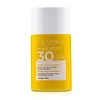What's inside
What's inside
 Key Ingredients
Key Ingredients

 Benefits
Benefits

 Concerns
Concerns

No concerns
 Ingredients Side-by-side
Ingredients Side-by-side

Water
Skin ConditioningDibutyl Adipate
EmollientDiethylamino Hydroxybenzoyl Hexyl Benzoate
UV FilterPropanediol
SolventDicaprylyl Carbonate
EmollientEthylhexyl Triazone
UV AbsorberMethylpropanediol
SolventBis-Ethylhexyloxyphenol Methoxyphenyl Triazine
Skin ConditioningPhenylbenzimidazole Sulfonic Acid
UV AbsorberArginine
MaskingC20-22 Alkyl Phosphate
EmulsifyingC20-22 Alcohols
Emulsion StabilisingBenzotriazolyl Dodecyl P-Cresol
UV AbsorberPalmitoyl Grape Seed Extract
Skin ConditioningGlycerin
HumectantCaprylyl Glycol
EmollientCaprylyl/Capryl Glucoside
CleansingEthylhexylglycerin
Skin ConditioningPotassium Cetyl Phosphate
EmulsifyingXanthan Gum
EmulsifyingPhenylpropanol
MaskingO-Cymen-5-Ol
AntimicrobialSodium Benzoate
MaskingPolyacrylate Crosspolymer-6
Emulsion StabilisingTocopheryl Acetate
AntioxidantPicea Abies Wood Extract
Helianthus Annuus Seed Oil
EmollientTocopherol
AntioxidantWater, Dibutyl Adipate, Diethylamino Hydroxybenzoyl Hexyl Benzoate, Propanediol, Dicaprylyl Carbonate, Ethylhexyl Triazone, Methylpropanediol, Bis-Ethylhexyloxyphenol Methoxyphenyl Triazine, Phenylbenzimidazole Sulfonic Acid, Arginine, C20-22 Alkyl Phosphate, C20-22 Alcohols, Benzotriazolyl Dodecyl P-Cresol, Palmitoyl Grape Seed Extract, Glycerin, Caprylyl Glycol, Caprylyl/Capryl Glucoside, Ethylhexylglycerin, Potassium Cetyl Phosphate, Xanthan Gum, Phenylpropanol, O-Cymen-5-Ol, Sodium Benzoate, Polyacrylate Crosspolymer-6, Tocopheryl Acetate, Picea Abies Wood Extract, Helianthus Annuus Seed Oil, Tocopherol
Dimethicone
EmollientZinc Oxide
Cosmetic ColorantWater
Skin ConditioningTitanium Dioxide
Cosmetic ColorantIsododecane
EmollientMethyl Trimethicone
Skin ConditioningPEG-10 Dimethicone
Skin ConditioningHexyl Laurate
EmollientSilica
AbrasivePolyglyceryl-4 Isostearate
EmulsifyingButylene Glycol
HumectantStearic Acid
CleansingPEG-9 Polydimethylsiloxyethyl Dimethicone
EmulsifyingSodium Chloride
MaskingAloe Barbadensis Leaf Juice
Skin ConditioningParfum
MaskingMannitol
HumectantAlumina
AbrasiveDimethicone/PEG-10/15 Crosspolymer
Phenoxyethanol
PreservativeAcrylates/Dimethicone Copolymer
Skin ConditioningGlycerin
HumectantSodium Citrate
BufferingTocopheryl Acetate
AntioxidantDisteardimonium Hectorite
StabilisingPropylene Carbonate
SolventCyclodextrin
AbsorbentPisum Sativum Extract
Skin ConditioningCassia Alata Leaf Extract
AstringentFaex Extract
Skin ConditioningDipropylene Glycol
HumectantDextrin
AbsorbentHydrolyzed Adansonia Digitata Extract
EmollientOlea Europaea Leaf Extract
PerfumingPlatanus Occidentalis Bark Extract
Skin ProtectingCitric Acid
BufferingPotassium Sorbate
PreservativeSodium Benzoate
MaskingTocopherol
AntioxidantDimethicone, Zinc Oxide, Water, Titanium Dioxide, Isododecane, Methyl Trimethicone, PEG-10 Dimethicone, Hexyl Laurate, Silica, Polyglyceryl-4 Isostearate, Butylene Glycol, Stearic Acid, PEG-9 Polydimethylsiloxyethyl Dimethicone, Sodium Chloride, Aloe Barbadensis Leaf Juice, Parfum, Mannitol, Alumina, Dimethicone/PEG-10/15 Crosspolymer, Phenoxyethanol, Acrylates/Dimethicone Copolymer, Glycerin, Sodium Citrate, Tocopheryl Acetate, Disteardimonium Hectorite, Propylene Carbonate, Cyclodextrin, Pisum Sativum Extract, Cassia Alata Leaf Extract, Faex Extract, Dipropylene Glycol, Dextrin, Hydrolyzed Adansonia Digitata Extract, Olea Europaea Leaf Extract, Platanus Occidentalis Bark Extract, Citric Acid, Potassium Sorbate, Sodium Benzoate, Tocopherol
 Reviews
Reviews

Ingredients Explained
These ingredients are found in both products.
Ingredients higher up in an ingredient list are typically present in a larger amount.
Glycerin is already naturally found in your skin. It helps moisturize and protect your skin.
A study from 2016 found glycerin to be more effective as a humectant than AHAs and hyaluronic acid.
As a humectant, it helps the skin stay hydrated by pulling moisture to your skin. The low molecular weight of glycerin allows it to pull moisture into the deeper layers of your skin.
Hydrated skin improves your skin barrier; Your skin barrier helps protect against irritants and bacteria.
Glycerin has also been found to have antimicrobial and antiviral properties. Due to these properties, glycerin is often used in wound and burn treatments.
In cosmetics, glycerin is usually derived from plants such as soybean or palm. However, it can also be sourced from animals, such as tallow or animal fat.
This ingredient is organic, colorless, odorless, and non-toxic.
Glycerin is the name for this ingredient in American English. British English uses Glycerol/Glycerine.
Learn more about GlycerinSodium Benzoate is a preservative. It's used in both cosmetic and food products to inhibit the growth of mold and bacteria. It is typically produced synthetically.
Both the US FDA and EU Health Committee have approved the use of sodium benzoate. In the US, levels of 0.1% (of the total product) are allowed.
Sodium benzoate works as a preservative by inhibiting the growth of bacteria inside of cells. It prevents the cell from fermenting a type of sugar using an enzyme called phosphofructokinase.
It is the salt of benzoic acid. Foods containing sodium benzoate include soda, salad dressings, condiments, fruit juices, wines, and snack foods.
Studies for using ascorbic acid and sodium benzoate in cosmetics are lacking, especially in skincare routines with multiple steps.
We always recommend speaking with a professional, such as a dermatologist, if you have any concerns.
Learn more about Sodium BenzoateTocopherol (also known as Vitamin E) is a common antioxidant used to help protect the skin from free-radicals and strengthen the skin barrier. It's also fat soluble - this means our skin is great at absorbing it.
Vitamin E also helps keep your natural skin lipids healthy. Your lipid skin barrier naturally consists of lipids, ceramides, and fatty acids. Vitamin E offers extra protection for your skin’s lipid barrier, keeping your skin healthy and nourished.
Another benefit is a bit of UV protection. Vitamin E helps reduce the damage caused by UVB rays. (It should not replace your sunscreen). Combining it with Vitamin C can decrease sunburned cells and hyperpigmentation after UV exposure.
You might have noticed Vitamin E + C often paired together. This is because it is great at stabilizing Vitamin C. Using the two together helps increase the effectiveness of both ingredients.
There are often claims that Vitamin E can reduce/prevent scarring, but these claims haven't been confirmed by scientific research.
Learn more about TocopherolTocopheryl Acetate is AKA Vitamin E. It is an antioxidant and protects your skin from free radicals. Free radicals damage the skin by breaking down collagen.
One study found using Tocopheryl Acetate with Vitamin C decreased the number of sunburned cells.
Tocopheryl Acetate is commonly found in both skincare and dietary supplements.
Learn more about Tocopheryl AcetateWater. It's the most common cosmetic ingredient of all. You'll usually see it at the top of ingredient lists, meaning that it makes up the largest part of the product.
So why is it so popular? Water most often acts as a solvent - this means that it helps dissolve other ingredients into the formulation.
You'll also recognize water as that liquid we all need to stay alive. If you see this, drink a glass of water. Stay hydrated!
Learn more about Water